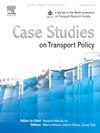Which unsafe riding behaviours are associated with traffic offences and crashes? A study of young Indonesian motorcyclists
IF 2.4
Q3 TRANSPORTATION
引用次数: 0
Abstract
Indonesia has high motorcycle dependence, especially among young riders who rely on them for access to education. The number of young riders aged 15–19 involved in crashes is higher than in any other age group. Despite this, there have been limited attempts to comprehensively understand the behaviour of these road users. This study is the first to use the Motorcycle Rider Behaviour Questionnaire (MRBQ) to determine which rider behaviours may predict crash risk in an Indonesian population. In addition, the impact of demographic variables such as age, gender, licensing status (licensed or unlicensed) and area of residence (urban or rural) on young Indonesian riders (N = 7,081) crash risk was also examined. Negative binomial regression analysis revealed that crash risk was positively associated with both intentional and unintentional unsafe behaviours, including “errors”, “speed”, and “unsociable riding”. Interestingly, a common theme in the “errors” identified involved the participant not paying attention to their surroundings. This suggests that even though these errors may be unintentional, there is a possibility to develop targeted safety interventions, such as combined rider awareness and riding skills training. Finally, the results revealed that many of those surveyed were riding on public roads before they reached the legal age for riding, and failed to obtain a license even when they could legally do so. Overall, this study provides valuable insights into the factors affecting the safety of young motorcyclists in Indonesia, taking into account the culture and environmental considerations unique to this country.
哪些不安全的骑行行为与交通违章和撞车有关?一项对印尼年轻摩托车手的研究
印度尼西亚对摩托车的依赖程度很高,特别是在依靠摩托车获得教育的年轻骑手中。15-19岁的年轻车手发生车祸的人数比其他任何年龄组都要多。尽管如此,全面了解这些道路使用者行为的尝试还是有限的。这项研究是第一次使用摩托车骑手行为问卷(MRBQ)来确定哪些骑手行为可以预测印度尼西亚人口中的碰撞风险。此外,还研究了年龄、性别、持牌状态(持牌或无牌)和居住地区(城市或农村)等人口变量对印尼年轻骑手(N = 7081)碰撞风险的影响。负二项回归分析显示,车祸风险与有意和无意的不安全行为呈正相关,包括“错误”、“速度”和“不合群的骑行”。有趣的是,“错误”的一个共同主题是参与者没有注意到周围的环境。这表明,即使这些错误可能是无意的,也有可能制定有针对性的安全干预措施,例如结合骑手意识和骑行技能培训。最后,调查结果显示,许多受访者在达到法定年龄之前就在公共道路上骑行,即使他们可以合法地这样做,也没有获得许可证。总的来说,考虑到这个国家独特的文化和环境因素,这项研究为影响印尼年轻摩托车手安全的因素提供了有价值的见解。
本文章由计算机程序翻译,如有差异,请以英文原文为准。
求助全文
约1分钟内获得全文
求助全文

 求助内容:
求助内容: 应助结果提醒方式:
应助结果提醒方式:


